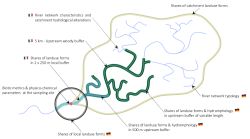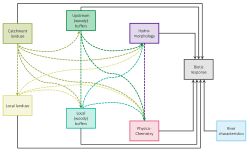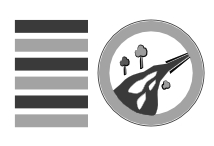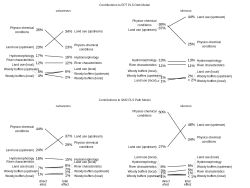The riparian ecotone plays an important role for stream ecosystems given the potentially severe impacts from adjacent landuse; such as intensive agricultural practices. Its role in structuring macroinvertebrate communities is still not yet fully understood but likely relies on these probably concomitant causes:
- Retention preventing nutrient, sediments and other chemical from terrestrial sources to enter the streams
- Shading preventing streams to heat but also regulating light availability for primary producers
- Provisioning of diverse habitats to both adult and larval stages
- Provisioning of organic matter recognised as elementary to the foodweb
Due to the characteristic longitudinal connectivity of rivers, these beneficial effects of woody buffers potentially add up and enhance river-type specific biodiversity in downstream direction. There are several experimental studies on the beneficial effect of woody buffers on abiotic habitat conditions and biota, locally and at reach scale. Several large-scale studies revealed a significant decrease in local biodiversity, if the upstream riparian buffer was in agricultural use compared to such covered by forest. In combination, these reach-scale and large-scale studies indicate a strong positive effect of upstream woody buffers on local biodiversity.
In this study, we compared the effects of woody buffers to the effects of a variety of stressors at the catchment, riparian and local scales to identify their relative importance in structuring aquatic invertebrate communities. We expected a strong positive effect of woody buffers on macroinvertebrate metrics.
In this project, we considered macroinvertebrate samples from 1082 sites in France and 1126 in Germany. The corresponding WFD quality indicators (I2M2 and multimetric index respectively) were used to assess the global effect of woody buffers on stream quality. Further, some community metrics were assessed to identify more intricate processes. For instance, Ephemeroptera, Plecoptera and Trichoptera (EPT) are of special interest as they:
- are known to be especially sensitive to water quality
- are sedentary and allow obtaining a spatial pattern of habitat conditions
- respond quickly to anthropogenic disturbances, resulting in modification of their composition and diversity and
- have an adult stage able to fly for which riparian trees are potentially important as resting spots, for reproductive behaviour and as guidance for dispersal.
To disentangle the different potential effects of woody buffers on aquatic macroinvertebrate communities and the spatial extent at which these occur, we defined two spatial scales for woody buffers, locally at the sampling site and few kilometres upstream (more information: table data comparison (pdf)).
Based on the analysis of very high-resolution aerial photos we defined the percentage of area covered by trees in the riparian corridor, which was at most 30 m wide. Additionally, we considered landuse shares of urban, agriculture, croplands and forest in the catchments from the best available resolution CORINE (France) and ATKIS (Germany) land cover databases, hydromorphological quality and measured or modelled physico-chemical parameters. Further information on the different data can be found here.

Fig. 1: Overview of the different scales brought together in the analysis. Variables specific to either country denoted by corresponding national flag.
All these variables were assembled in different variants of structural equation models (SEM), basically mapping the hypothesized direct and indirect causal relationships between the different variables, through the spatial scales and landscape elements

Fig. 2: Graphical presentation of the structural equation models in the analysis. Solid arrows denote direct effects whereas dashed links denote the hypothesised relationships between the different scales of latent variables, which can be combined to represent indirect effect pathways.
The SEM approach allows quantifying direct as well as indirect effects on the riverine community composition and structure and thus establishing interactions between woody riparian buffers, landuse, habitat and water quality with respect to their benefiting aquatic macroinvertebrates.
Our main findings are:
“Biotic responses are well explained by the model”
About half of the variance of the river-type specific biodiversity was explained by the model, which is a large variance explained for an empirical and especially such large-scale studies.
“High effect of catchment landuse and physico-chemistry”
The biotic response is by far most strongly affected by catchment landuse and physico-chemistry.
“Low effect of local and upstream woody buffers”
Woody buffers had a low direct effect on the biotic response as well as indirectly through other pathways like physico-chemistry. However, upstream woody buffers have a stronger influence on macroinvertebrate communities relative to local woody buffers.
“Woody buffers are no one-size-fits all management option for biodiversity protection”
In literature, field studies and empirical analyses of larger datasets found that woody buffers have the potential to locally mitigate detrimental effects of agriculture or urbanisation on freshwater macroinvertebrates communities. In this study, we conversely observed that estimated effects of both local and upstream woody buffers on aquatic macroinvertebrates are low and subordinate to the effect of catchment landuse. This divergence from most common literature could be due to the fact that previous studies were conducted more locally and thus did not introduce variation in the catchment characteristics as we did in this study. Thus, while we consent that woody buffer can have a strong effect in particular conditions, this does not hold true for a more global analysis. Our last finding however underlines the importance to consider woody buffers as a continuous protective corridor rather than a local mitigation measure.
Therefore, as far as possible, woody buffer should be continuously implemented to show their full potential, while further investigations might be proposed to improve models to identify the pressure contexts in which woody buffers work best, for instance by segmenting the dataset according to landuse gradients, allowing a better focus on local effects.
“Catchment-scale river management is needed to support woody buffers”
While our results might point to woody buffers as potentially ineffective restoration measures their apparent divergence from most common literature merely underlines that woody buffers alone do not meet all demands of river management. We are also able to reinforce the notion that landuse practices still govern the health of aquatic ecosystems and ultimately landuse policies might have untapped potential in this regard through regulation of agricultural techniques and continued efforts with respect to maintaining and improving water quality.
Aquatic macroinvertebrate communities are known for being good indicators of river disturbances. Many drivers have been proven to cause shifts in communities composition and structure, such as pollution or water quality decrease, alterations to hydrological regimes, or increased temperature. Therefore, both other functions of woody riparian buffers studied in the OSCAR project, namely retention potential and water temperature regulation, play an important role for biodiversity , through more intricate mechanisms than currently in the SEM model.
Together the German and French datasets cover an extensive spatial range making the conclusions directly applicable to large parts of Central Europe. Besides, the identification of landuse as primary driver of macroinvertebrates communities responses in large statistical studies is already well accepted further enhancing the general relevance of our studies.
For more detailed information two upcoming publications will be linked here once ready.
This research has been funded through the 2015-2016 BiodivERsA COFUND call for research proposals, with the national funders German Federal Ministry of Education and Research (01LC1618A), Agence National de la Recherche (ANR-16-EBI3-0015-01) and Research Council of Norway (268704/E50). OSCAR project website





